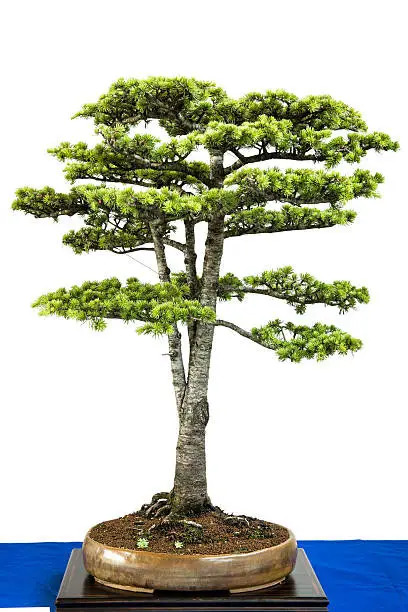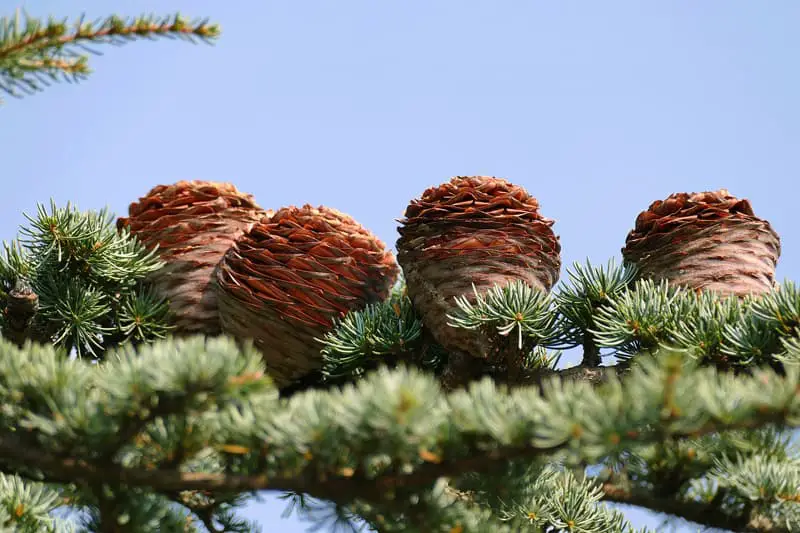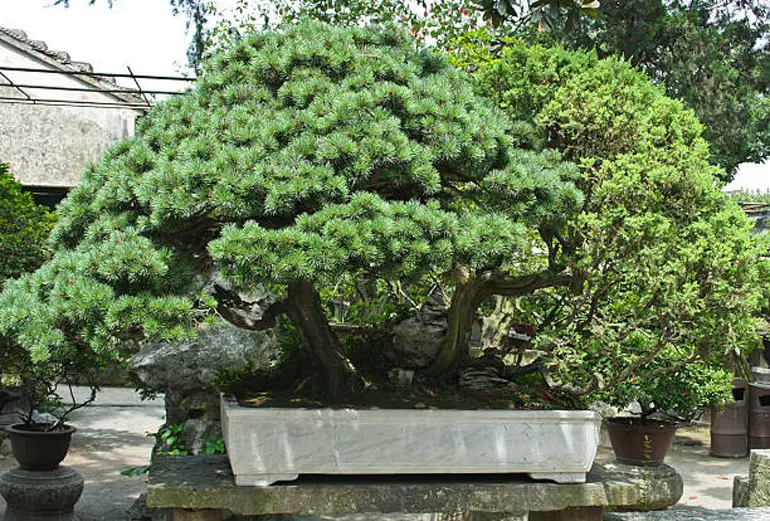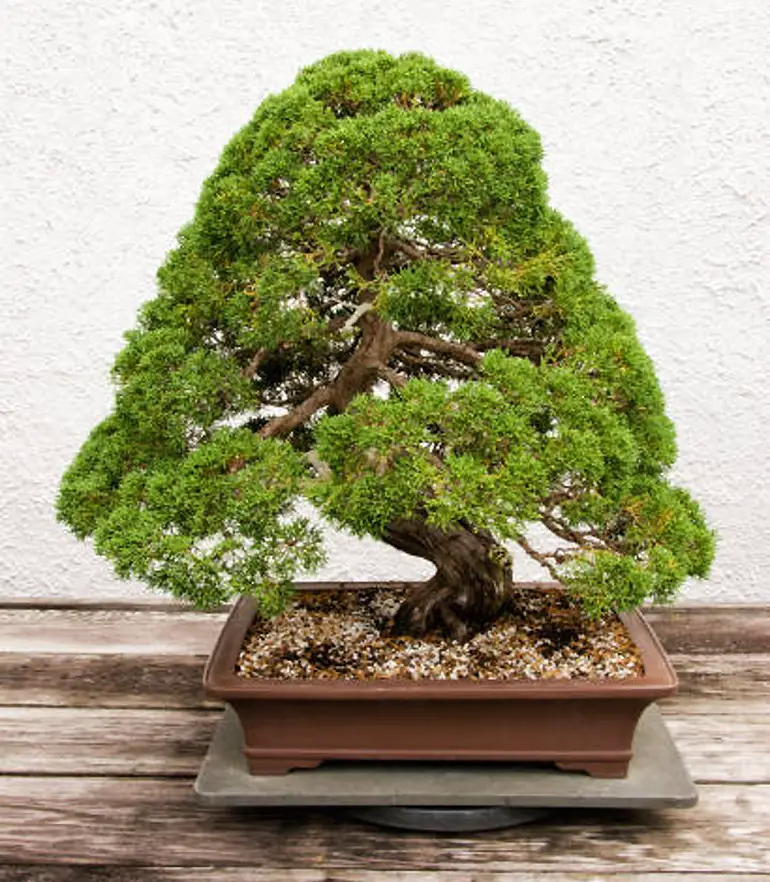Table of Contents
Cedar Bonsai is a beautiful coniferous tree with unique traits found wanting in most trees used for Bonsai. For me, the beauty and uniqueness of the Cedar tree are not only limited to its leaves and trunk; but its rarity.

Although there are about 5 species of cedar tree, looking for one to grow is as difficult as going for a treasure hunt. What even makes the Cedar tree more interesting to me is that they are a slow-growing plant and are not ideal for an amateur Bonsai grower except you are an ardent grower willing to test your skill to the limit.
If you would love to have this unique and dramatic nice tree in your Bonsai collection, read this article for everything you need to know about the tree, and how to treat them in the best possible way.
| Scientific name | Cedrus Libani |
| Average height | 40 to 60 feet ( 480 to 720 inches tall ) |
| Average spread | 40 to 60 feet |
| Origin country | Southwestern Asia, Syria |
| Family | Pinaceae |
| Leaf | Evergreen |
| Water | Moderate |
| Sunlight | Full sun |
| Maintenance | Medium |
Cedar Bonsai History

The Cedar tree has been used to serve lots of purposes in the past and the tree is of great significance to many ancient cultures. The tree constituted the major material used by the Phoenicians to make ships and build houses. To the Sumerians, it means another thing entirely as they believed it to be a sacred symbol. They regarded the Cedar grove as the favorite place for the gods to live in, and they have the tradition of burning the tree during festive periods.
The Cedar tree also has an imprint in the religious realm as well. The tree is recognized in the Bible as well as the Talmud, the holy books of the Christians and the Jews. They are seen in both books as a symbol of relics as they were used in ancient times to build houses. The Cedar tree was used for the construction of King Solomon’s Temple, as well as the houses of King David and King Solomon.
The Cedar tree also provided mankind with one of its earliest sources of fragrance. The tree has resinous oil which was used by the ancient Egyptians to make embalming products. They also used the woods of the tree to make coffins known as sarcophagi in an ancient language. These woods were so durable that you can still find relics of them in Egypt today, after about 3000 years.
After Noah survived the great flooding, it was narrated that he made an offering with the Cedarwood and myrtle incense as thanksgiving. It is also a common tradition of the Tibetan monasteries to burn Cedarwood as incense.
Can you Bonsai a Cedar tree?
Yes, you can Bonsai a Cedar tree. Cedar trees are attractive and will make an excellent Bonsai specimen, so you can try them out if you desire to have one. However, you should know that using a Cedar tree as a Bonsai specimen will test your strength, patience, and perseverance because they are not easy to style and have a slow growth habit.
Cedar Bonsai scientific name
The scientific name of the Cedar tree is Cedrus Libani.
Cedar Bonsai care
Growing a Cedar Bonsai is challenging, but having adequate knowledge about how best to treat the tree will go a long way with getting things right even though it might take a longer route before you start to see the desired effect. Check below for information about the care requirements necessary for the upkeep of a Cedar tree.
Cedar Bonsai temperature
Cedar Bonsai is not cold tolerant, so it must be protected against exposure to any temperature level below 25°c. They will survive any temperature level beyond that.
Cedar Bonsai Fertilizer
You can use any liquid or solid organic fertilizer for your Cedar Bonsai tree. Apply solid fertilizer to your Cedar Bonsai at least once in 4 weeks during its active (growing) season. And should also be applied once at the beginning of winter (dormant period), further application should be delayed to the beginning of spring.
Liquid fertilizers should be applied to your plant at least once a week during its active period (growing season). During its dormant period (winter), the use of fertilizer should be reduced to just once a month.
Bonus: Make sure the fertilizer is well diluted to half its strength with water before application to prevent vigorous extraneous sprouts and root damage. You should also ensure the soil is moist before using the fertilizer and also remember to water the soil after balanced fertilizer application.
Cedar Bonsai pruning & trimming
New growth and twigs should be pruned during spring. New growth that emerges after pruning later during the season should also be trimmed back regularly. It is best to delay the pruning of larger Branches to Autumn and avoid cutting back the needles.
How to prune Cedar Bonsai
Cedar Bonsai is a slow-growing tree, therefore it only requires little or no regular pruning most times. They also prefer that their new growth are pinched back rather than carrying out vigorous pruning on them. Therefore, you should avoid pruning your Cedar tree extensively.
Pruning a Cedar Bonsai is pretty easy, all you need is sharp sterilized scissors to make necessary cuts. Avoid cutting the needles and if you desire to have it shaped to form needles, new growth should only be pinched back during spring when new buds are starting to grow. Older growth should be pruned during Autumn.
Cedar Bonsai repotting
The last thing every Cedar Bonsai want is repotting their roots: they don’t like being transplanted. Repotting a Cedar Bonsai will severely weaken the tree’s system and will become vulnerable to diseases; the more reason one must be extremely careful when repotting a Cedar tree and also report only when repotting becomes necessary.
When to repot a Cedar Bonsai
The best time to prune a Cedar Bonsai is during spring when new sprouts are just opening up. This should be done at least once in 5 years.
Younger Cedars need to be reported more frequently, therefore, you must watch them closely to ensure they stay healthy. If your young Cedar has stunted growth, it might be an indication that it needs to be repotted.
You should use acidic soil that can drain well when making soil mix for your Cedar tree. Also, do not heavily prune the tree, but rather prune its root lightly so that the shock will not be too much for the root to absorb. Do not prune the root ball at all unless it is necessary.
Cedar Bonsai pests & diseases
Cedar trees are highly susceptible to Aphid. Although they can be affected by other diseases like the Fungi Sirococcus as well as the pestalotia, which causes crumbling leaves and shoot blight, Aphid is more common. Cedar trees are also likely to be affected by root rot which is mostly a result of inappropriate watering plans or wrong choice of soil.
The first approach to attacking any of these infections is the general improvement of the condition under which your Cedar tree is raised. Then identify the exact pest and diseases affecting your tree, then administer the specific pesticide or fungicide appropriate for the treatment.
If the infection is caused by overwatering, it can be corrected by repotting the tree. This is the best way you can control the growth and spread of mildew and molds in the root of the tree.
Cedar Bonsai soil
The best soil for a Cedar Bonsai is a mixture comprising mostly of inorganic aggregates. Premixed soils are readily available at garden stores, you can either buy from there or make one at the comfort of your home by mixing lava rock, akadama, and pine bark. This mixture retains and drains the excess water so that the soil does not become soggy.
The pine bark included in the mixture will increase the acidity of the soil, while also providing organic nourishment to the tree at the same time.
Cedar Bonsai watering
Cedar trees need to be watered frequently (everyday) during their growing season. Also, you should make sure the soil nearly dries before applying water and prevent total dry out by all means necessary. A yellow Cedar leave is an indication of overwatering, so be on the lookout for such signs and make necessary adjustments as needed.
Cedar Bonsai sunlight requirement
Cedar trees like lots of sun and love to be placed where they can be exposed to direct sunlight. And they must remain there for at least 6 hours a day. You can leave it there for more than 6 hours but anything less could be detrimental to the health of your tree.
Cedar Bonsai types

There are several Cedar species, but only 4 of them are widely grown as Bonsai. These 4 species are; Cyprus Cedar, Cedar of Lebanon, Himalayan Cedar, and the Atlas Cedar. Check below for individual descriptions of these species and others.
Cyprus Cedar Bonsai
The Cyprus Cedar is native to Cyprus and can grow as tall as 80 ft (24m). But when grown as a Bonsai specimen, it can only grow as tall as 50ft (15m). Cyprus cedar is preferred over the Lebanon Cedar because it is more suitable for large gardens where a Lebanon Cedar will usually grow to be a large tree.
They have clusters of spirally arranged tiny needles on their short, woody branches. The cone of the tree starts as green but as it matures, it changes to light brown. It has grayish-brown brown that cracks open when the tree matures. They are also easily recognizable with their horizontal branches.
Deodar Cedar Bonsai
The Deodar Cedar is also known as the Himalayan Cedar is an evergreen tree species that can grow as tall as 150ft (50m) when fully matured; it has a trunk that can grow up to 3m (10ft) in diameter. The crown of a young Deodar cedar is conical and has droopy leaders and branches that droop at the ends. The branches become rounded as they age.
Atlas Cedar Bonsai
The Atlas Cedar Bonsai is an artistic tree specimen with distinctive evergreen features. It has various needle colors varying from bluish-green to silver-blue that making it attractive on any landscape. When given enough space to grow, it will develop into a large, aesthetic, and tough tree.
The Atlas Cedar is also very useful in the furniture industry as the woods of the tree are used in making chairs and furniture drawers. The tree became one of the top choices within the industry after it was discovered that the aromatic oil produced by the tree is a natural restraint for insects.
Cedar of Lebanon Bonsai
The Cedar of Lebanon also commonly called Lebanon Cedar is an evergreen coniferous tree characterized by its irregular shape and is used as an impressive addition to a landscape. The tree originates from the middle east (Lebanon) and is seen as one of the original Cedar trees. Also, of all the whole Cedar species, it is the coldest tolerant.
The Cedar of Lebanon is a slow-growing plant and can only add 10 to 15 inches tall per year. However, don’t be fooled by their slow growth as a Cedar of Lebanon tree can grow as tall as 100 feet and can live for about 600 years or more, making them one of the best shade trees as they mature. The leaves of a Cedar of Lebanon have unique fragrances and are usually rich-green or greenish-gray.
Japanese Cedar Bonsai
The Japanese Cedar is also known as Cryptomeria which means “hidden part” is a deciduous tree that is virtually everywhere in Japan. It is a beautiful tree and puts on a more glamorous appearance as it grows. The tree owes its popularity not just to its beauty, but its striking pyramidal shape with thick branches that layout in concentric circles. It can grow as tall as 150ft. (45m) with a circumference of about 4.5 to 7.5m.
Eastern Red Cedar Bonsai
The Eastern Red Cesar also known as the red Jupiter or the pencil cedar belongs to the family of Cupressaceae and are popular for their appealing appearance, incredibly strong, and small to the medium-sized structure. The tree can be found in northern and eastern America.
The tree can live for an average of 300 years (the oldest Eastern red Cedar is 940 years) and they exhibit a slow growth rate. A typical Red Cedar can only add 13 to 24 inches in height per year.
Blue Atlas Cedar Bonsai
The Blue Atlas Cedar is sure one of the most attention-grabbing trees, thanks to its cascading branches and its sculptural structure which gave it its unique appearance. The evergreen tree is indigenous to the Atlas mountain, a geographical location in North Africa. The tree belongs to the family of Pinaceae and the Cedrus genus.
It has very slow growth and can only grow one foot taller per year with a maturity age of 10 years or thereabout. It is a natural Bonsai tree and is best planted during spring or fall.
Western Red Cedar Bonsai
The Western Red Cedar is not considered to be a true Cedar and it is mostly referred to as a false Cedar. This tree can be largely found in areas like Pacific Northwest America and acclimatized by great Britain. It can also be found anyplace around the sea level and can grow to an astonishing height of 7510ft around that area. But if grown as Bonsai, it can be trimmed to a standard size.
The tree is best grown under shady, moist, and cool conditions.
White Cedar Bonsai
The Eastern White Cedar is also known as the “little Jaime” belongs to the family of Cupressaceous, native to Maine U.S.A. The tree can also be sparsely found in some areas on the Mexican Gulf Coast. It is an evergreen deciduous tree with feather-like leaves that spreads out in Pure green or Bluish-green color.
It is a slow-growing plant and a matured White Cedar can grow as tall as 40 feet tall. Its canopy can spread across 12 feet (3.6m). It has upright pyramid-shaped branches that give it a distinguished contour, providing it with a notable landscape shape, making it suitable for cultivation in large gardens.
Cedar Elm Bonsai
The Cedar Elm tree belongs to the family of Ulmaceae. The tree can be found in areas around Eastern Texas down to Northern Louisiana as well as Southern Arkansas. A typical Cedar Elm tree can grow as tall as 80ft. It has elliptical-shaped leaves with either blunt or sharp pointed tips.
It is a slow-growth plant but has a vigorous root system and requires to be root-pruned at least once in 2 years or every 3 years as the situation may require to prevent the tree from weakening.
Cedar Pine Bonsai
The Cedar Pine is an evergreen coniferous tree native to North America. It is one of the most rarely seen Pine trees in the United States. The Cedar Pine is an attractive tree that has an open crown. It can grow as tall as 100ft (30cm) in the forest with a thickness of about 1cm. But when used as a Bonsai specimen, it can be trimmed to a considerably short size.
Cedar Bonsai is an indoor or outdoor plant?

You can either grow a Cedar Bonsai outdoor or indoor; they will thrive well in both situations. However, Cedar Bonsai will grow better when cultivated outdoors: you must always make sure to take them in once the temperature level drops below 20°c.
Cedar Bonsai starter kit
In a typical Cedar Bonsai kit, you will essential components necessary for the general maintenance and pruning of your tree. Items to be found in a Cedar Bonsai kit include;
- Bonsai fertilizer
- Humidity tray
- Bonsai pocket Guide
- Maniatured Cedar Bonsai
- Aluminium Bonsai training wire
How to Bonsai a Cedar tree
You can start a Cedar tree cultivation with either cedar seed or a young Cedar tree less than 2 years. You can get the tree or seedling from the countryside if you live in areas where the tree is largely grown or you can buy it from a nursery.
The Cedar tree, especially Lebanon and the Cyprus Cedar makes an excellent Bonsai; however, a young Cedar specimen is usually scarce, so you may have to ask around for a while before getting one: check below for the process involved in starting a Cedar Bonsai.
- Put the Cedar seedling in a Bonsai container. The container will help stimulate stunted growth for your Bonsai tree. Check the root-ball of the seedlings and clip off any lateral roots that twist around the root ball at the tips.
- Transplant the Cedar tree to another container with well-drained fresh soil that has high sand content. Smoothen the soil surface, then spread half-inch layer of sphagnum moss.
- Prune the Cedar tree to the desired shape. Check for branches growing on the bottom half of the tree and cut them off. The main leader should be trimmed down to the height of the longest side branch. Branches growing on the trunk should be pruned to create spaces for branches growing in opposing directions to other branches. About 2/3 of the branch leftovers on one side should be left untouched.
- Cut a flexible wire that is twice as long as your Cedar tree. Stick one end of the wire into the soil close to the bottom of the tree. Then wrap the wire around the tree at the trunk. The wire should be twisted into a spiral shape to form a slight angle that pulls the tree’s top sideways alongside most branches. The tree should be left in this position for the first growing year.
- Take your Bonsai tree to a place where it can be exposed to enough sunlight and should be thoroughly watered thereafter every 5 or 7 days.
- Fertilize the tree at the beginning of spring using fertilizers specially made for Cedar trees.
- Pinch out new branches the moment they start to grow on the trunk by removing only the branch buds that are preventing the growth of your Bonsai.
How to grow Japanese Cedar Bonsai from seed
The Japanese Cedar is one of the widely grown Cedar species. Check below for information on how to cultivate this incredible trees from seed.
- Fill up a Bonsai container or pot with standard potting compost. Then smoothen the surface of the compost and sow the seed.
- The seed should be covered with at least two millimeters of vermiculite bonsai soil mix. Water the plant and keep it a room temperature. The seed should start germinating within a few weeks.
![Pittosporum Bonsai [Pittosporum Tobira]](https://www.bonsai-express.com/wp-content/uploads/2022/05/Pittosporum-Bonsai-365x200.jpg)
![Sorbus Bonsai [Sorbus Aucuparia]](https://www.bonsai-express.com/wp-content/uploads/2022/05/Sorbus-Bonsai-365x200.jpg)
![Tsuga Bonsai [Tsuga Canadensis]](https://www.bonsai-express.com/wp-content/uploads/2022/05/Tsuga-Bonsai-365x200.jpg)
![Tamarix Bonsai [Tamarix Ramosissima]](https://www.bonsai-express.com/wp-content/uploads/2022/05/Tamarix-Bonsai-365x200.jpg)